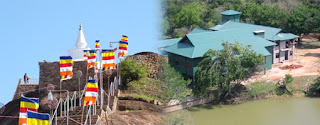Sunday, May 8, 2011
Sithulpauwa
Sithulpawwa rock temple is historically significant and identified as one of the greatest 2nd century sites of Buddhist scholarship. With a history of over 2200 years, this is an ancient place of worship in the Hambantota district. The modern name Sithulpawwa is derived from the ancient ‘Cittalpabbata’, ‘The hill of the quiet mind’. It is said that in the 1st century AD as many as 12,000 Arahants lived here (monks that have achieved the highest mind level in Buddhism). Unlike the great monasteries in Anuradhapura and other towns, life at Sithulpawwa was hard and a monk or nun lived there only if they were interested in silence and solitude. Located opposite the Maha Sithulpawwa rock which is 400 feet (122M) in height is a cave temple. This cave temple, which is 67 feet high and 30 feet long, is part of the intricate cave-complex at Sithulpawwa.
The Dagoba of Sithulpawwa can be seen on the top of the rock. It is believed to have been built by King Kawantissa (100-140AD). A number of caves contain inscriptions in the early Brahmi script and from these inscriptions it was learned that a number of villages donated money to this temple for its upkeep. Ancient literary works give interesting information relating to this shrine. The image house at Sithulpawwa still contains some fragments of paintings. In the eastern precinct of Sithulpawwa the ruins of an ancient preaching house can be seen, where a cluster of 10 feet high pillars rises from the earth.
The Dagoba of Sithulpawwa can be seen on the top of the rock. It is believed to have been built by King Kawantissa (100-140AD). A number of caves contain inscriptions in the early Brahmi script and from these inscriptions it was learned that a number of villages donated money to this temple for its upkeep. Ancient literary works give interesting information relating to this shrine. The image house at Sithulpawwa still contains some fragments of paintings. In the eastern precinct of Sithulpawwa the ruins of an ancient preaching house can be seen, where a cluster of 10 feet high pillars rises from the earth.
Subscribe to:
Comments (Atom)






